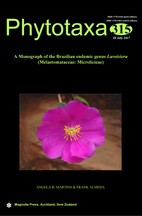Abstract
A systematic monograph is presented for Lavoisiera, a Brazilian endemic genus of 41 species that is centered in the campo rupestre ecoregion in the Brazilian Planalto south of the Amazon basin, mostly west of the Mata Atlântica (Atlantic Rainforest), and east of the Pantanal. The stronghold for species diversity is the state of Minas Gerais with 36 species, 30 of which are endemic there. This study represents the first comprehensive monograph of the genus based on field work across its distributional range, complemented by examination of over 3620 specimens from 35 herbaria. An evaluation of taxonomic characters used in the long-standing sectional classification of the genus has led to its abandonment because it is based on artificial characters and does not provide a sound working hypothesis of infrageneric relationships. Eight new species are described: L. arachnoidea, L. belinelloi, L. canastrensis, L. daviesiana, L. minima, L. rundeliana, L. setosa, and L. vestita; lectotypifications are provided for L. caryophyllea, L. chamaepitys, L. glandulifera, L. pulchella, and L. senae; and 44 epithets are relegated to synonymy. An identification key, full synonymy, descriptions, habitat and phenological information, distribution maps, diagnostic illustrations, images of representative species in the field, and geospatial conservation assessments are provided for all species based on IUCN criteria. SEM images of seed morphology are presented for nearly half of the species along with camera lucida drawings of meiotic chromosome figures for selected species, and an index to numbered collections examined.

